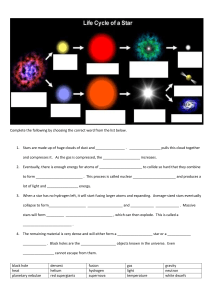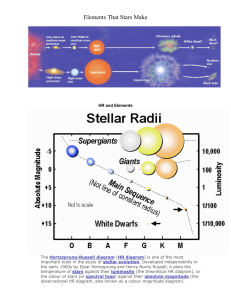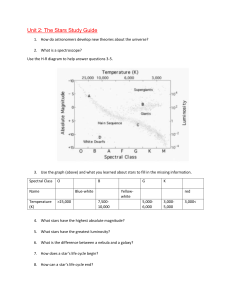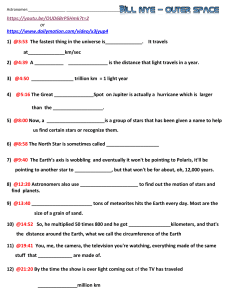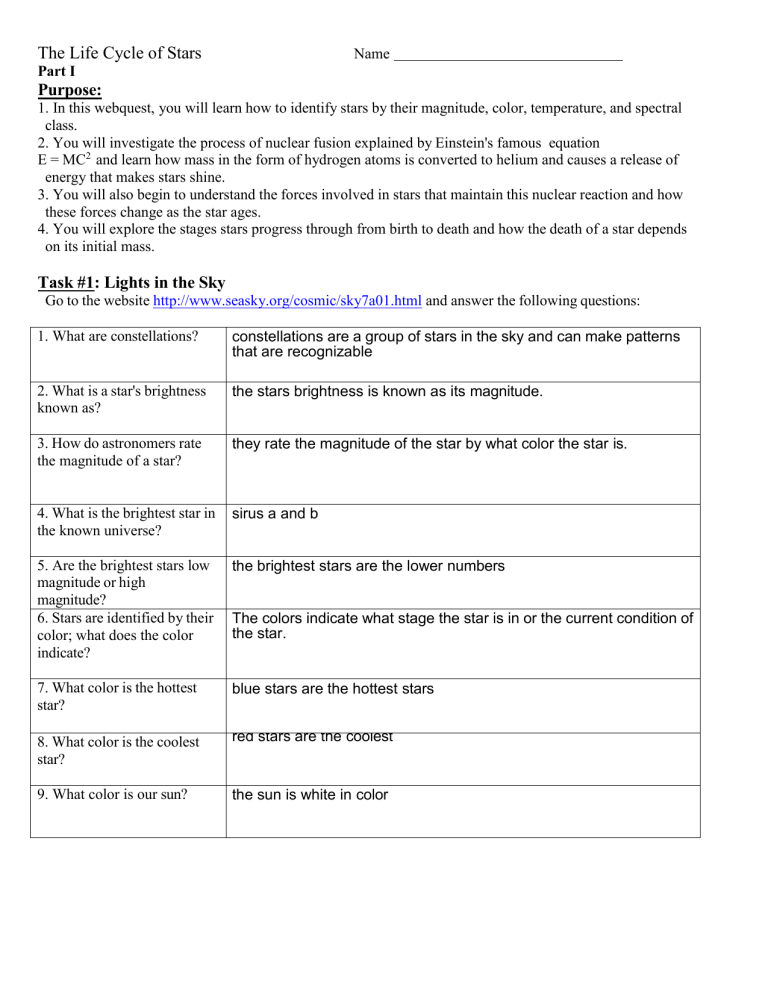
The Life Cycle of Stars 1 Name Part I Purpose: 1. In this webquest, you will learn how to identify stars by their magnitude, color, temperature, and spectral class. 2. You will investigate the process of nuclear fusion explained by Einstein's famous equation E = MC2 and learn how mass in the form of hydrogen atoms is converted to helium and causes a release of energy that makes stars shine. 3. You will also begin to understand the forces involved in stars that maintain this nuclear reaction and how these forces change as the star ages. 4. You will explore the stages stars progress through from birth to death and how the death of a star depends on its initial mass. Task #1: Lights in the Sky Go to the website http://www.seasky.org/cosmic/sky7a01.html and answer the following questions: 1. What are constellations? constellations are a group of stars in the sky and can make patterns that are recognizable 2. What is a star's brightness known as? the stars brightness is known as its magnitude. 3. How do astronomers rate the magnitude of a star? they rate the magnitude of the star by what color the star is. 4. What is the brightest star in the known universe? sirus a and b 5. Are the brightest stars low magnitude or high magnitude? 6. Stars are identified by their color; what does the color indicate? the brightest stars are the lower numbers 7. What color is the hottest star? blue stars are the hottest stars 8. What color is the coolest star? red stars are the coolest 9. What color is our sun? the sun is white in color The colors indicate what stage the star is in or the current condition of the star. Task #2: A Nuclear Furnace Continue to read on to the section “A Nuclear Furnace” on the same webpage http://www.seasky.org/cosmic/sky7a01.html and answer the following questions: 1. The nuclear reactions this process is known as fusion inside a star, such as our sun, convert hydrogen into helium by means of a process known as. 2. What gives a star its when fusion happens that creates energy for the star energy? 3. How many protons does a standard hydrogen atom have in its nucleus? 4. How many neutrons does a standard hydrogen atom have in its nucleus? 5. The animation shows how stars fuse the hydrogen deuterium and hydrogen tritium to form helium. Use colored pencil to draw a diagram that shows this nuclear reaction. Label the names of the atoms and draw arrows showing the progression of the reaction . 1 proton Deuterium has one neutron and a tritium has 2 I have the drawing Task #3: The Circle of Life Continue to read on to the section “The Circle of Life” on the same webpage http://www.seasky.org/cosmic/sky7a01.html and answer the following questions: 1. Stars begin their lives as clouds of dust and gas called. nebulae 2. What is a protostar? This is the gravity of a passing star or shock wave causes the nebula to contract matter will condense 3. When does nuclear fusion begin? when the proctor condenses and starts to heat up causing nucleari fusion. 4. The life span of a star depends on size 5. Very large, massive stars burn their fuel much than smaller stars. 6. The life span of smaller stars are much than that of large, massive stars faster shorter 7. When will a star become a red giant? when the stars fuel begins to run out 8. Why do some stars become super red giant? they are massive star 9. What will happen when a star exhausts its remaining fuel? the star will collapse and turn into a planetary nebula if the star is big enough and can explode 10. What is a planetary nebula? when a star loses fuel and collapses and the pressure and nuc lear are not strong enough then a planetary nebula is formed 11. What is a white dwarf? when a star starts to run out of fuel 12. What produces all of the heavy elements required for life? cycle of cellular evolution 13. What are we made of? the same stuff that made stars 14. Using colored pencils, draw a diagram of the life cycle of a star: I have the drawing Task #4: Types of Stars Continue to read on to the section “Types of Stars” on the same webpage http://www.seasky.org/cosmic/sky7a01.html and answer the following questions: 1. What does the main sequence represent? when it maintains a stable nuclear reaction 2. Is our sun a main sequence star? yes 3. What will decide the its mass amount of time a star spends in the main sequence phase? 4. Large, massive stars will have a short massive stars will have a longer _ main sequence stage while less main sequence stage. 5. What is a red giant? a big star that is red or orange late phase in the life of a star 6. What is a white dwarf? the end stage of a stars life.
